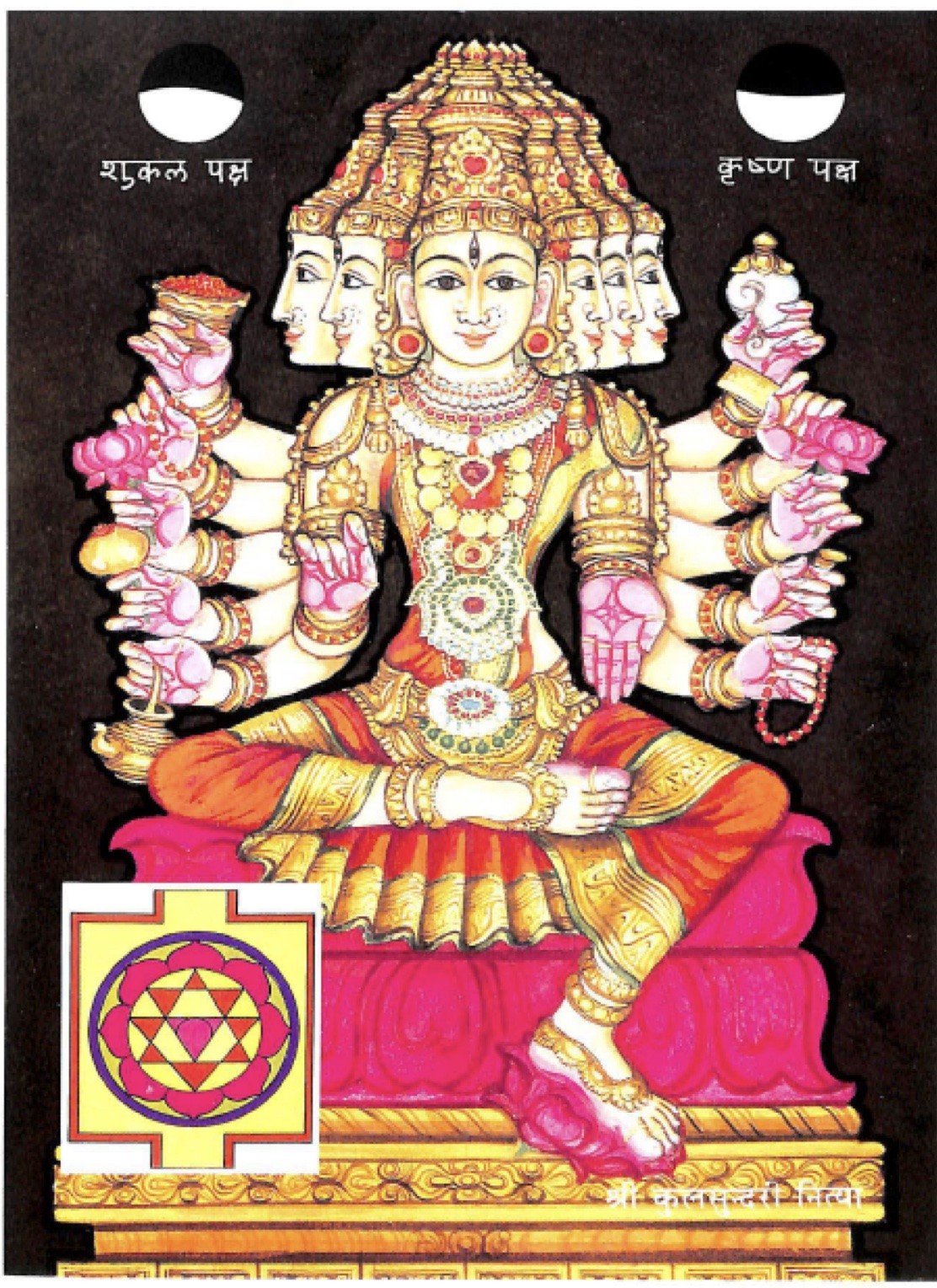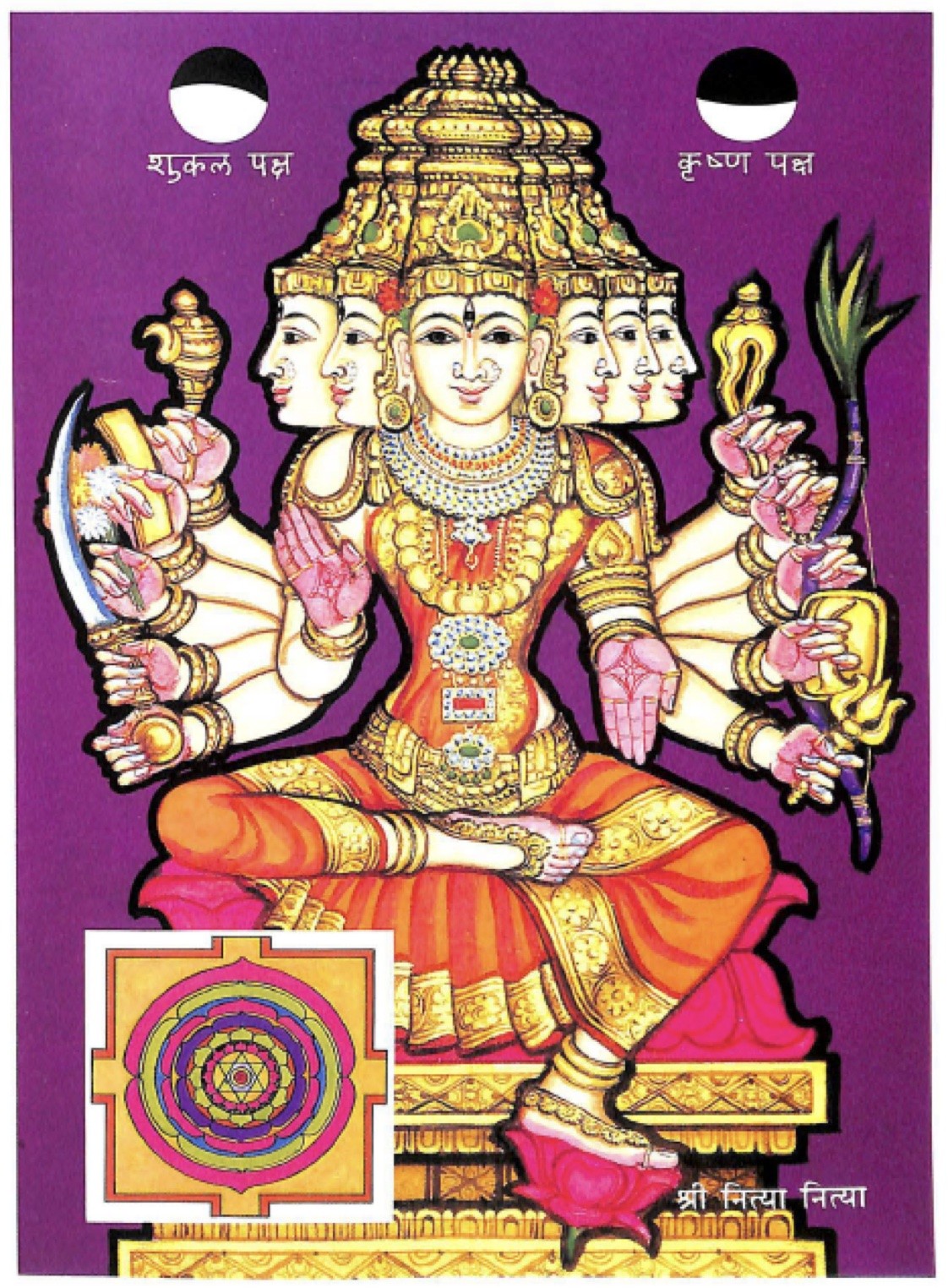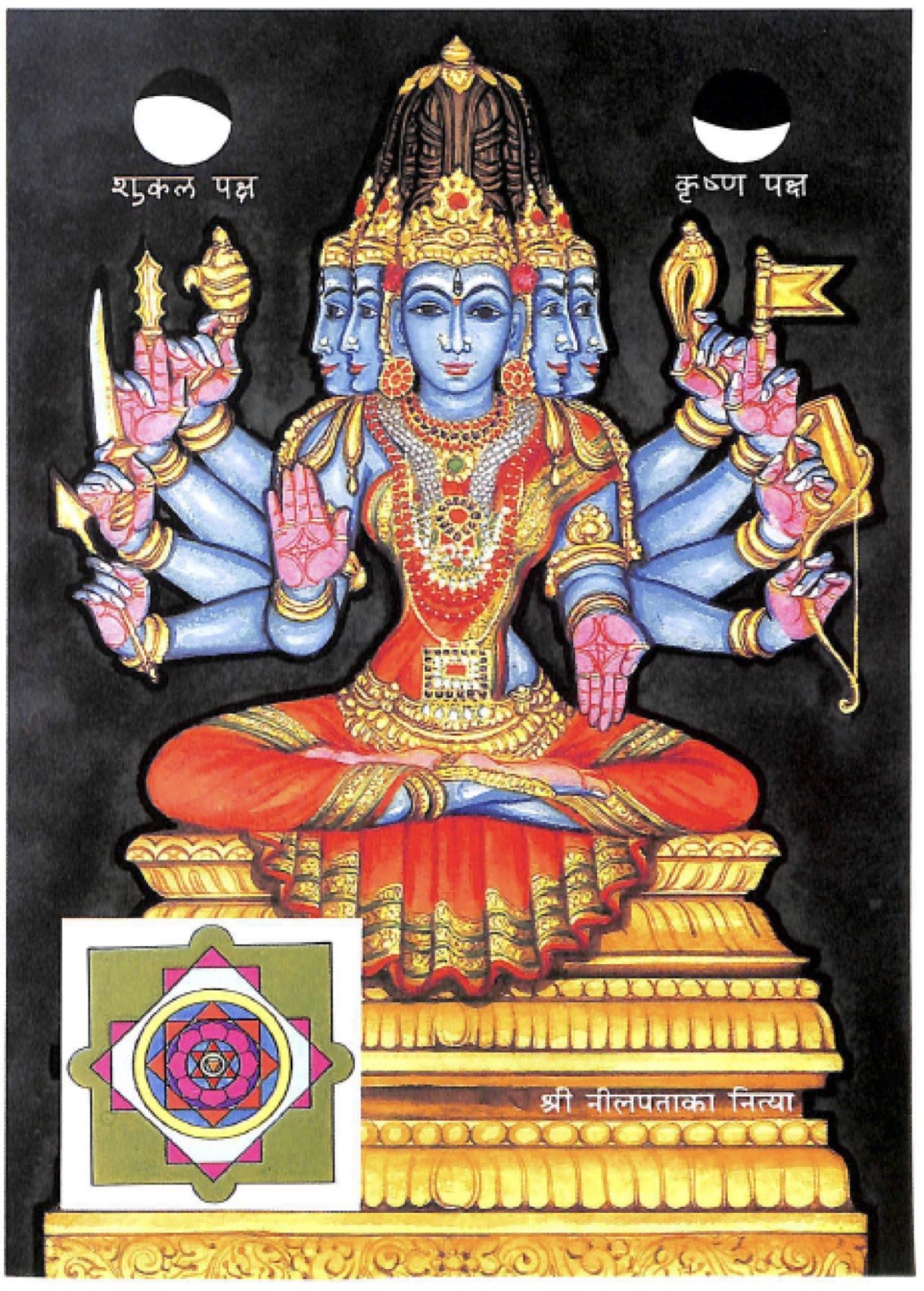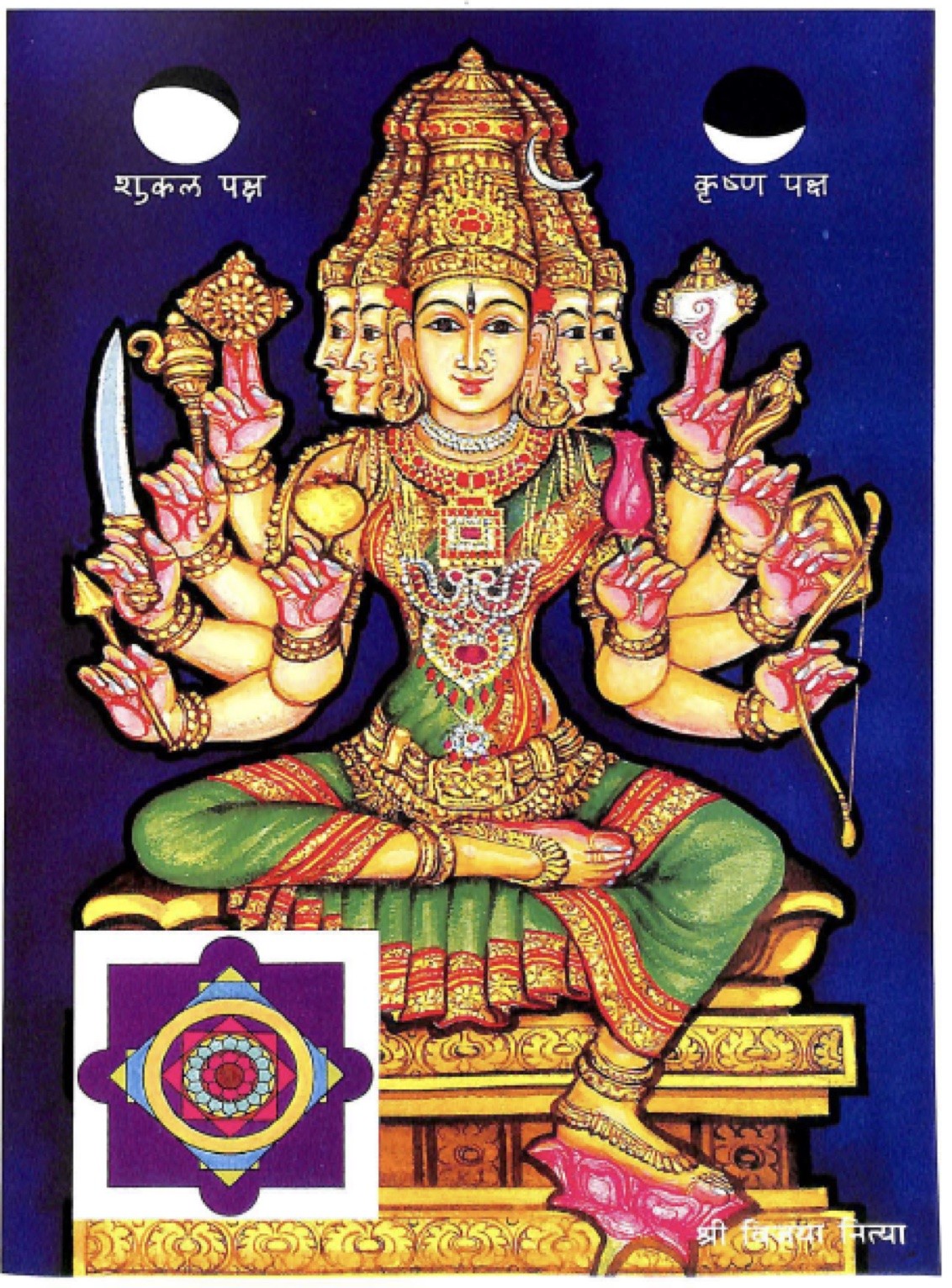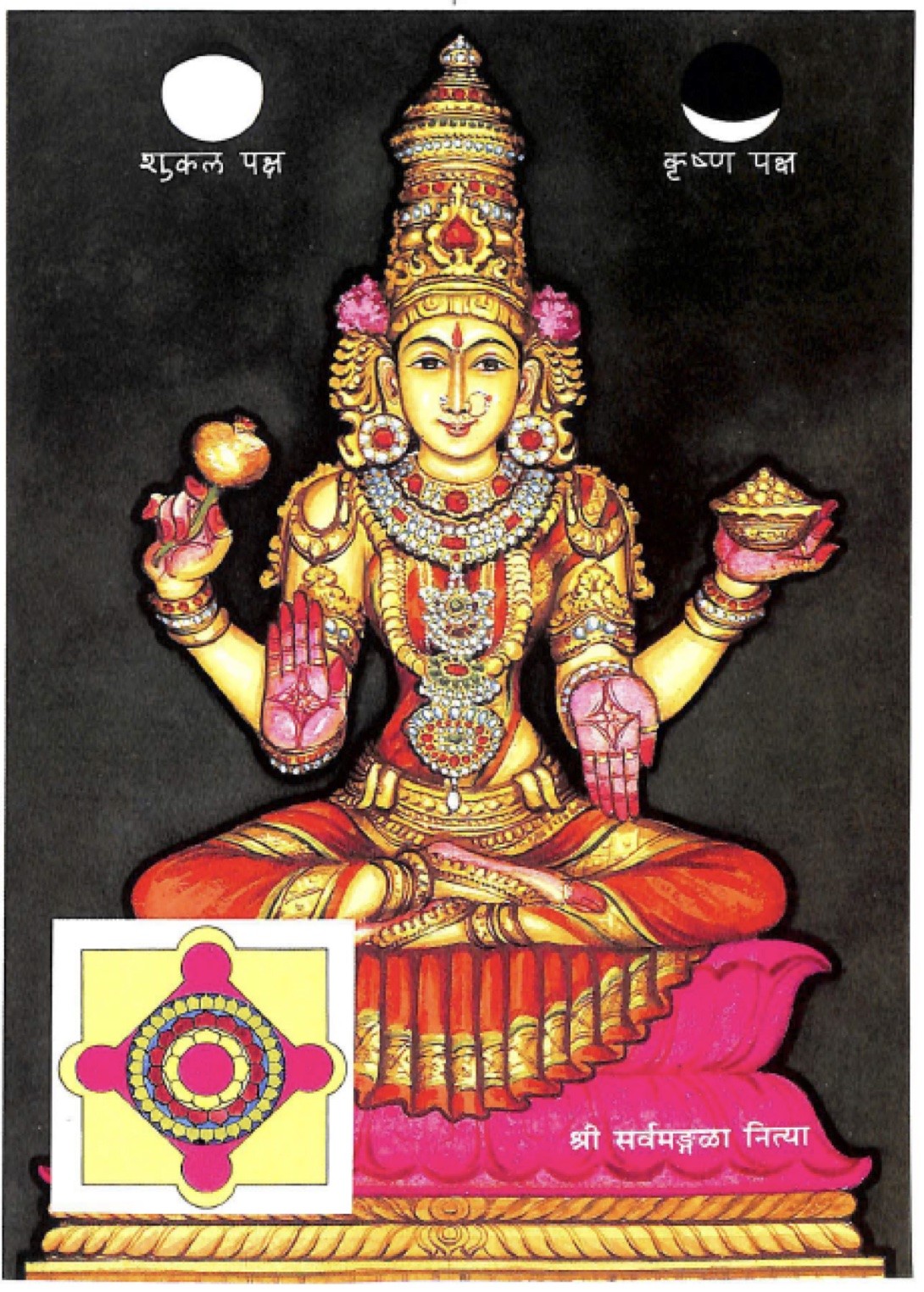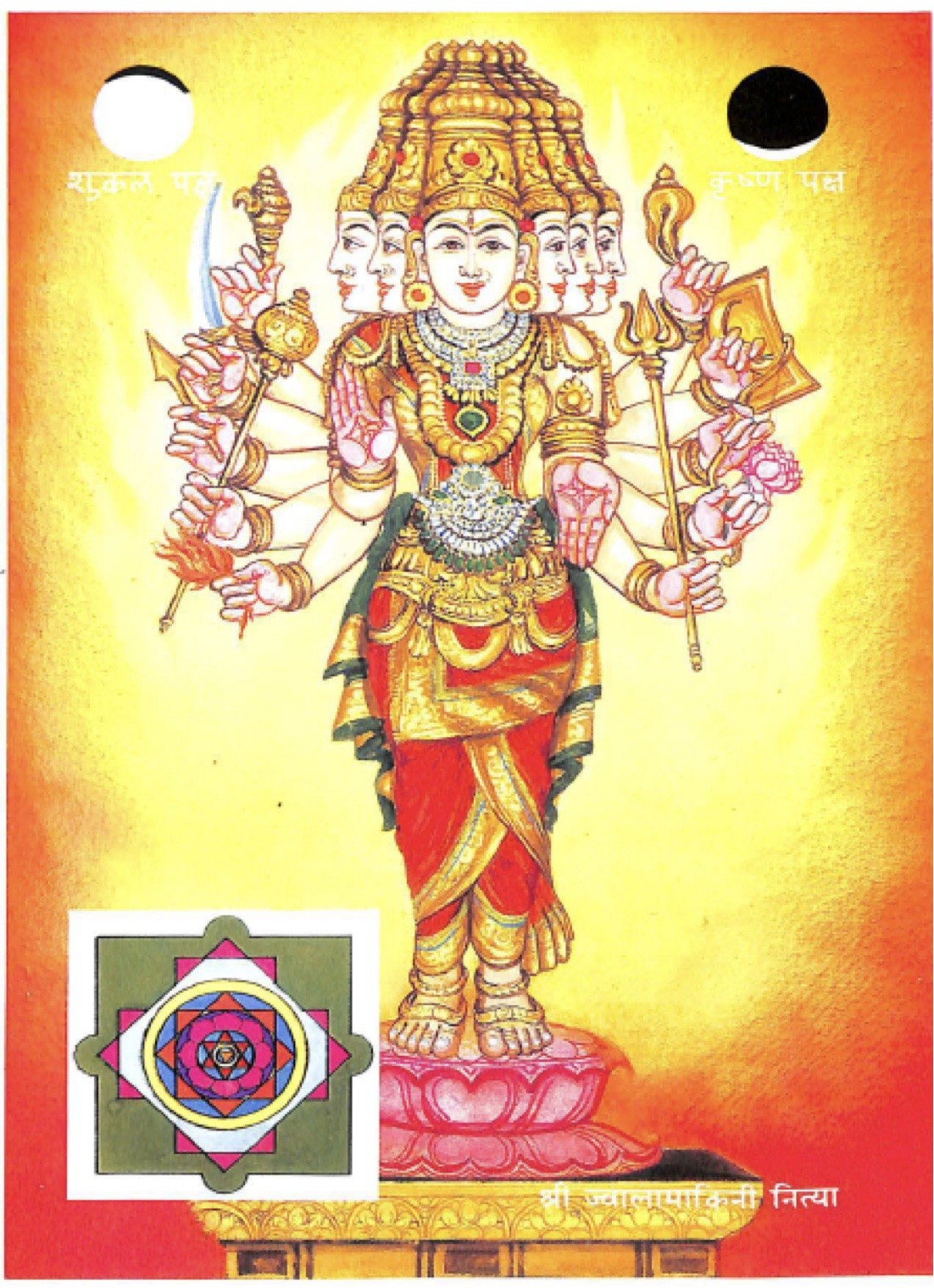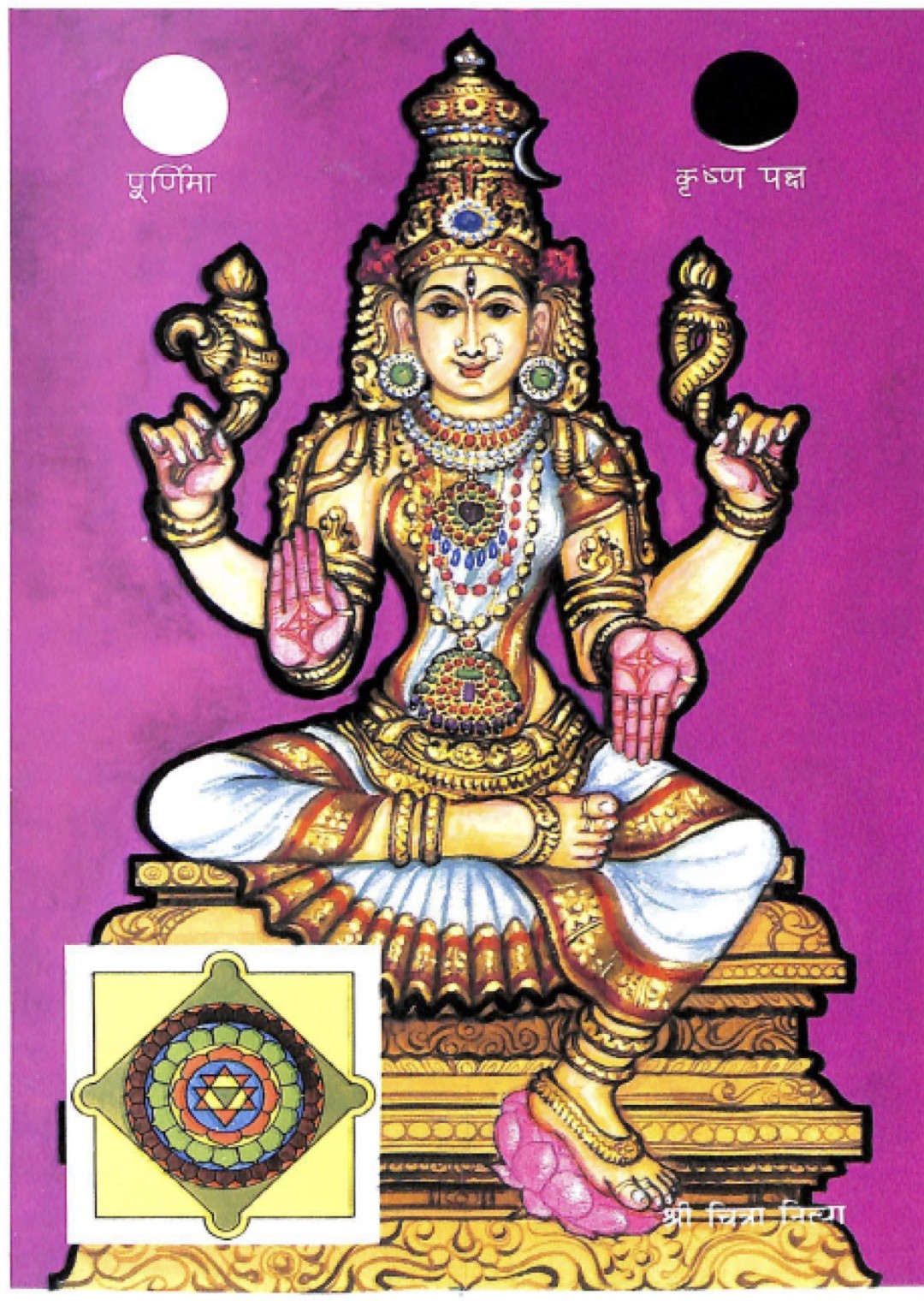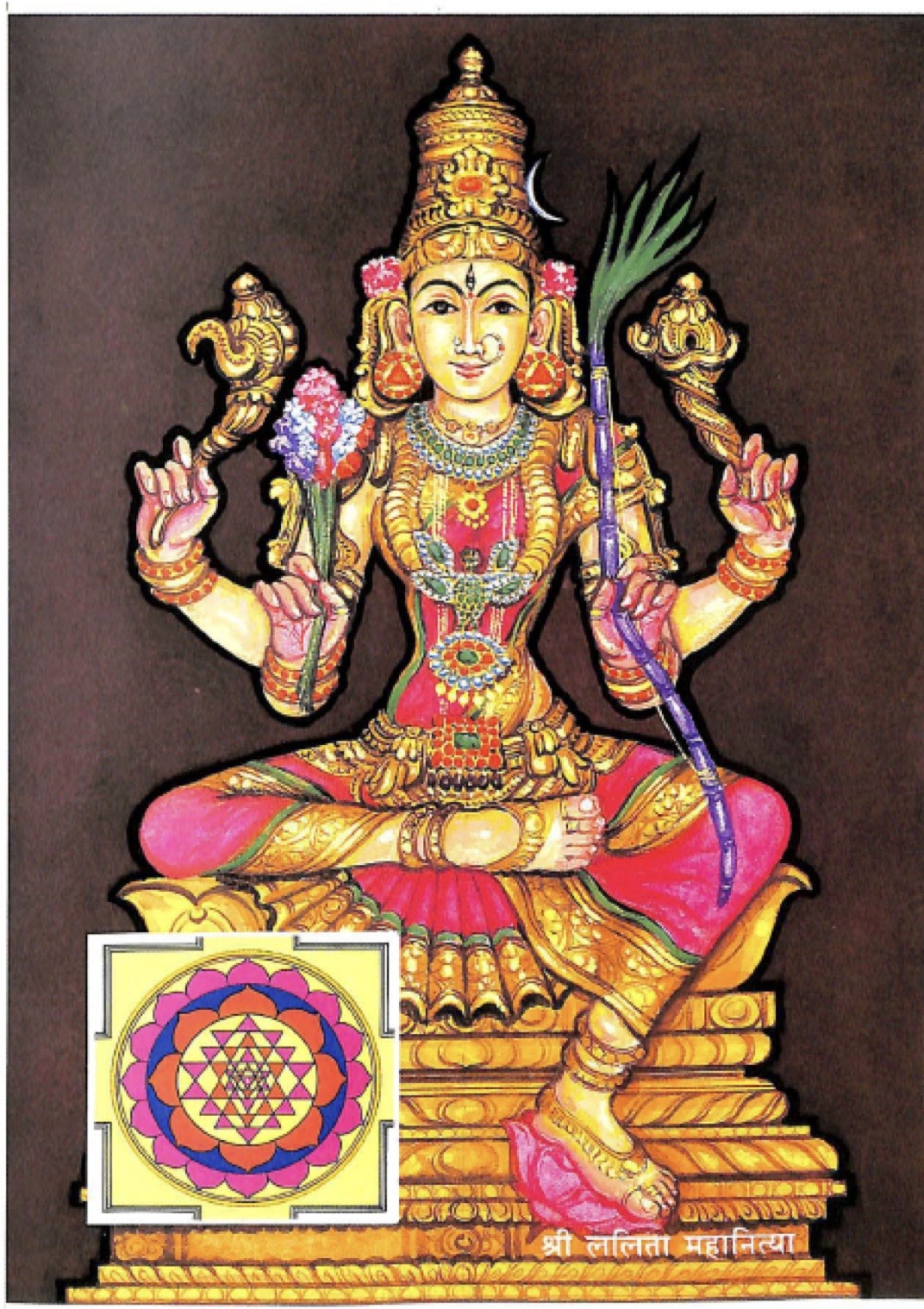- Edited
"The chakra of the letters of the alphabet is based upon time and so is identical with the sidereal zodiac." - Tantraraja Tantra
The Nityas or Eternities of Lalita represent the fifteen lunar days or tithis of the waxing Moon. Each has her own yantra, mantra, tantra and prayogas or ritual applications. The full circle of the Nityas also represents the 21,600 breaths a human being takes in a full day and night. As such, the Nityas are the Kalachakra, or Wheel of Time.
The information in this section is drawn from a number of tantras including the Tantraraja, the Dakshinamurti Samhita and the Jnanarnava Tantra, as well as the Kalpasutra, which seems to be the primary source. Readers will also find it useful to refer to Sir John Woodroffe's digest of the Tantraraja (Ganesh & Co, 1971), although here he fails to give sufficient idea of the number of prayogas (magical rites) associated with the Nityas. Yantras and mantras, where given, are drawn from Tantraraja, although it is necessary to point out that the Dakshinamurti Samhita gives somewhat different versions.
You can find larger versions of the yantras according to the Tantrarajatantraon this page.
The 15 Nityas are modifications of Lalita as red goddess with her three gunas and her five elements of aether, air, fire, water and earth. As the moon remains itself, though appearing differently according to phase, so too does Lalita. Each Nitya has her own vidya (that is mantra), yantra and group of energies (Shaktis). Their names appear in the first chapter of Vamakeshvara Tantra. Gopinath Kaviraj, a renowned scholar of tantra in the first half of this century, describes the Kalachakra and the Nityas succinctly in the introduction to the Sanskrit edition of Yogini Hridaya. (Sarasvati Bhavana Granthamala, 1963):
"What the Bhavanopanishad says implies that the Human Body is to be conceived as the Sri Cakra, being the expression of one's own self. (Svatma). This means that while on the one hand the Body is to be regarded as non-different from the atma, the entire cosmic system associated with the body should also be viewed in the same light. This outer system in its manifestation rests on Time (kala), Space (deha) and a combination of the two. The exponents of the School hold that the well known fifteen Kalas of the Moon, representing the 15 lunar tithis, are to be regarded as identical with the fifteen Nityas (Kameshvari to Citra). The sixteenth Kala called Sadakhya should be viewed as one with Lalita or the Supreme Deity Herself. In other words, one has to feel that what appears in Kalacakra is nothing but an expression of what exists eternally as Nityas in the supreme Sri Cakra itself. The tithicakra or the wheel of time is constantly revolving and the Sri Cakra is within it and not without. It should also be remembered that from the standpoint of an esoteric yogin the tithis are in the last analysis to be identified with the 21600 shvasas supposed to be the average number of breaths per day of a normal human being."
Hence Lalita or Tripurasundari is the 16th day or full moon, with her 15 digits. Each of the Nityas has a certain number of arms, the totality of arms (= rays) of the whole circle being 108. Because any unit of time is taken as a microcosm or parallel of any other valid unit, each of the fifteen Nityas thus has 1,440 breaths (see Bhavanopanishad). This identity between space, time, Tripurasundari and the individual is elaborated at great length and with considerable sophistication by the author of the Tantraraja.
According to that text, the Nityas are the vowels of the Sanskrit alphabet and are identical with both time and space. For example, if the number of tattvas or consonants (36) are multiplied by the 16 Nityas the number of letters is 576. The multiples of this number provide the number of years in the different Yugas. So the circle of the matrikas and the Nityas is identical with the sidereal zodiac as well as mantra.
This theme is further elaborated in the 28th chapter of the same tantra, where Shiva says that in the centre of the world is the Meru, outside of this being the seven oceans and beyond this the Kalachakra or wheel of time which moves in a clockwise direction by the power of Iccha (Will) Shakti. The circle is divided by 12 spokes and the planets or grahas are within this. Lalita, says the tantra, is in the Meru, while 14 Nityas from Kameshvari to Jvalamalini reside in the seven islands and seven oceans. Chitra, who is the 16th Nitya, occupies supreme Space or Paramavyoma.
In the Dakshinamurti Samhita, the Nityas are identified with kalas or parts of the different stages of deep sleep, dreaming, waking, and full consciousness or Turiya. Here it is said that the Nityas, including Lalita, are the 16 parts of the continuum of consciousness, while the 17th Kala is beyond all of this. Each of the Nityas has the respective vowel letter associated with her mantra vidya.
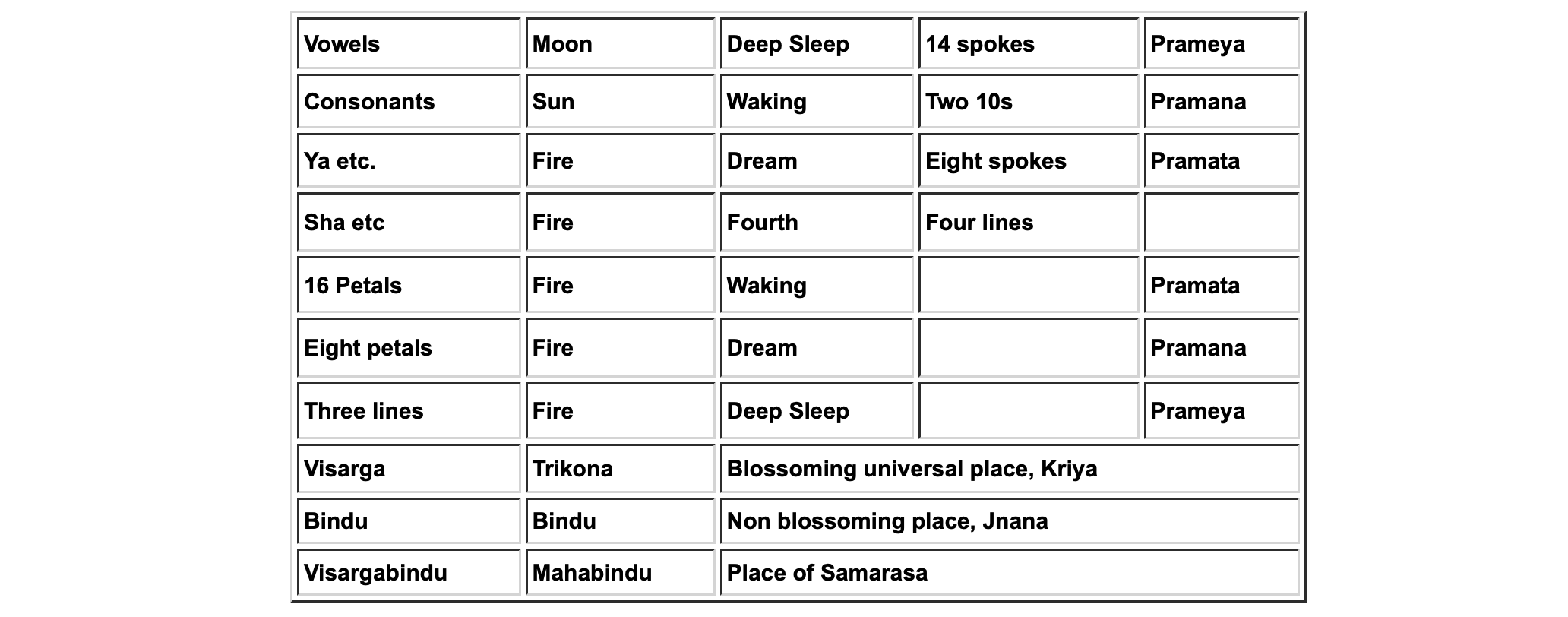
Similar ideas are found in the Matrikachakra Viveka, as in the table above, drawn from the Sanskrit introduction to the 1934 Government Sanskrit College of Benares edition, which classifies the nine mandalas of the Shri Yantra according to Pramana - means of knowledge, Pramata - the subject, and Prameya - the object and relates the different states of consciousness to the yantra. See Tattvas on this site.
According to the Tantraraja, the 15 Nityas are limbs or rays of Lalita, who is herself pure consciousness without additions. Varahiand Kurukulla bear the relationship of father and mother respectively. The Nityas themselves can be meditated upon and worshipped in different forms and colours for the attainment of different ends. In daily worship (puja) of the Nityas, each has her own nyasa and ritual sequence and they are to receive puja on the lunar days associated with them. The vidya mantras of the different Nityas below are prefaced by Aim Hrim Shrim bija mantras and suffixed with Shri Padukam Pujayami Tarpayami Namah, that is Hail. I worship and libate the auspicious lotus feet [of the appropriate Nitya].
The images embedded in the text above are taken from a sadhaka's manuscript of the 1,000 names of Lalita.


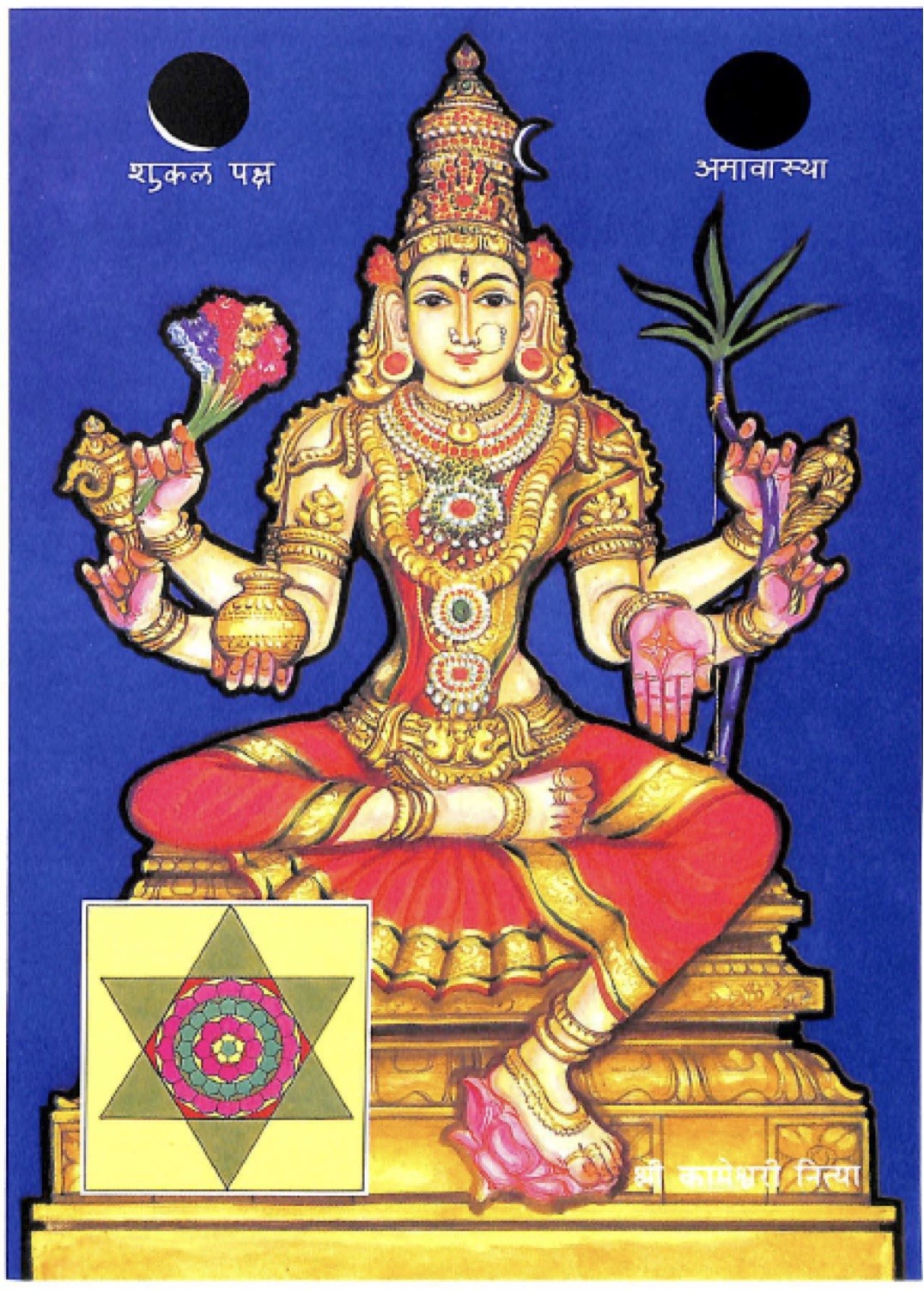
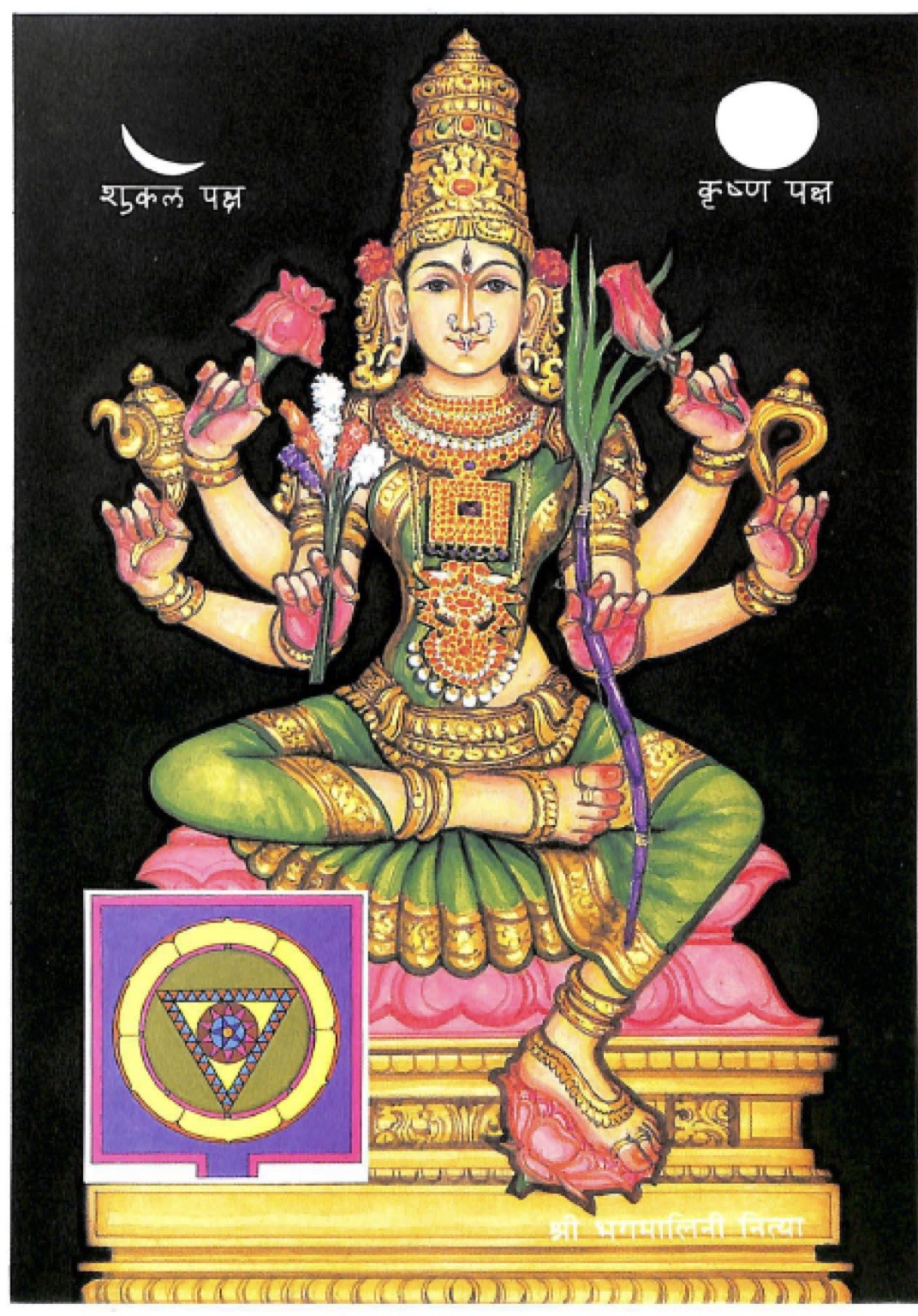 Nitya Bhagamalini, whose name refers to the flowering yoni, is the second of the cycle of the waxing Moon and has a remarkable and very long vidya (mantra) which runs: Aim Hrim Shrim Am Aim Bhagabuge Bhagini Bhagodari Bhagamale Bhagavahe Bhagaguhye Bhagayoni Bhaganipatini Sarvabhagavashankari Bhagarupe Nityaklinne Bhagasvarupe Sarvani Bhagani Me Hyanaya Varade Rete Surete Bhagaklinne Klinnadrave Kledaya Dravaya Amoghe Bhagavicce Kshubha Kshobhaya Sarvasatvan Bhagodari Aim Blum Jem Blum Bhem Blum Mom Blum Hem Blum Hem Klinne Sarvani Bhagani Me Vashamanaya Strim Hara Blem Hrim Am Bhagamalini Nitya Shri Padukam Pujayami Tarpayami Namah.
Nitya Bhagamalini, whose name refers to the flowering yoni, is the second of the cycle of the waxing Moon and has a remarkable and very long vidya (mantra) which runs: Aim Hrim Shrim Am Aim Bhagabuge Bhagini Bhagodari Bhagamale Bhagavahe Bhagaguhye Bhagayoni Bhaganipatini Sarvabhagavashankari Bhagarupe Nityaklinne Bhagasvarupe Sarvani Bhagani Me Hyanaya Varade Rete Surete Bhagaklinne Klinnadrave Kledaya Dravaya Amoghe Bhagavicce Kshubha Kshobhaya Sarvasatvan Bhagodari Aim Blum Jem Blum Bhem Blum Mom Blum Hem Blum Hem Klinne Sarvani Bhagani Me Vashamanaya Strim Hara Blem Hrim Am Bhagamalini Nitya Shri Padukam Pujayami Tarpayami Namah.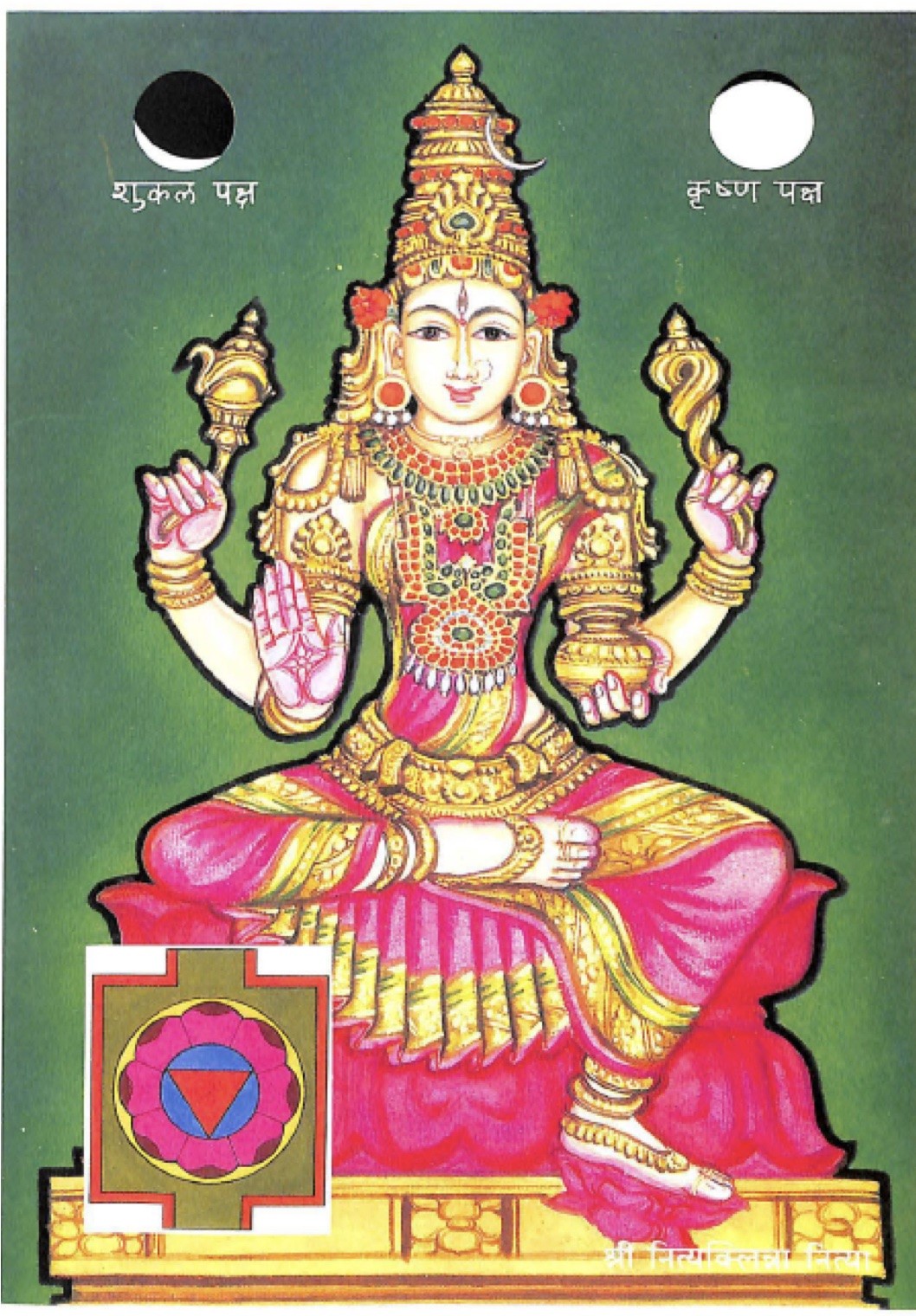
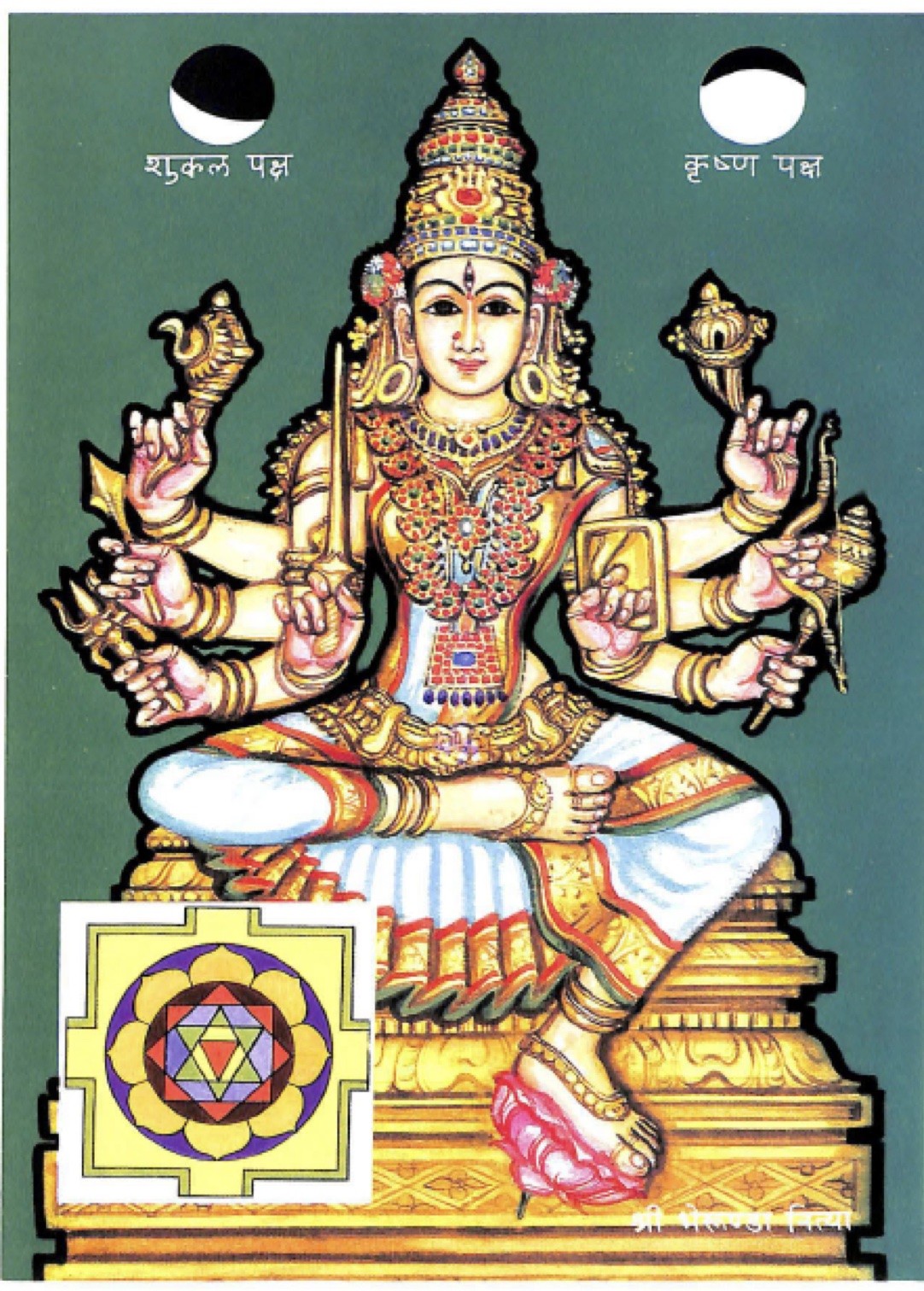
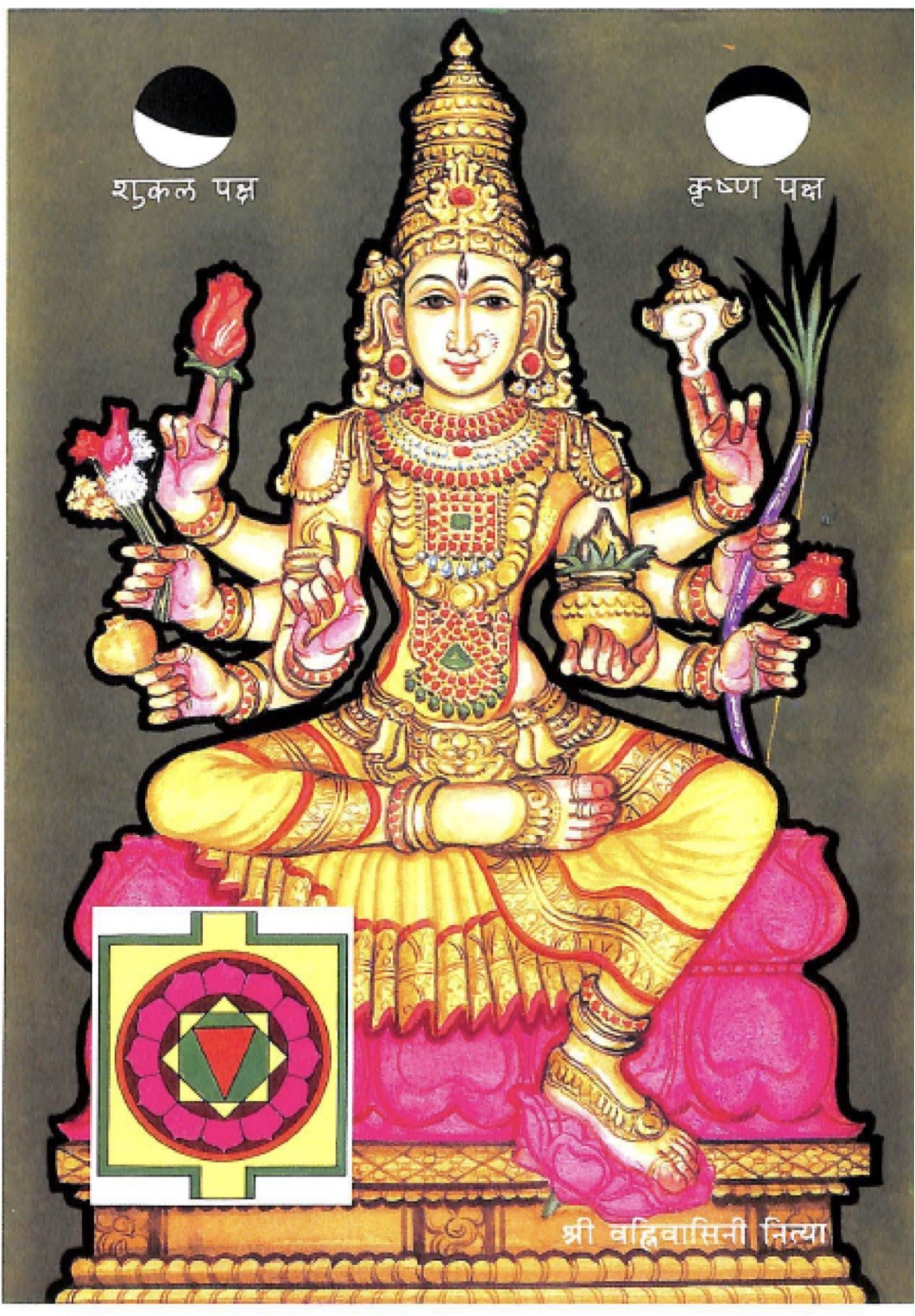
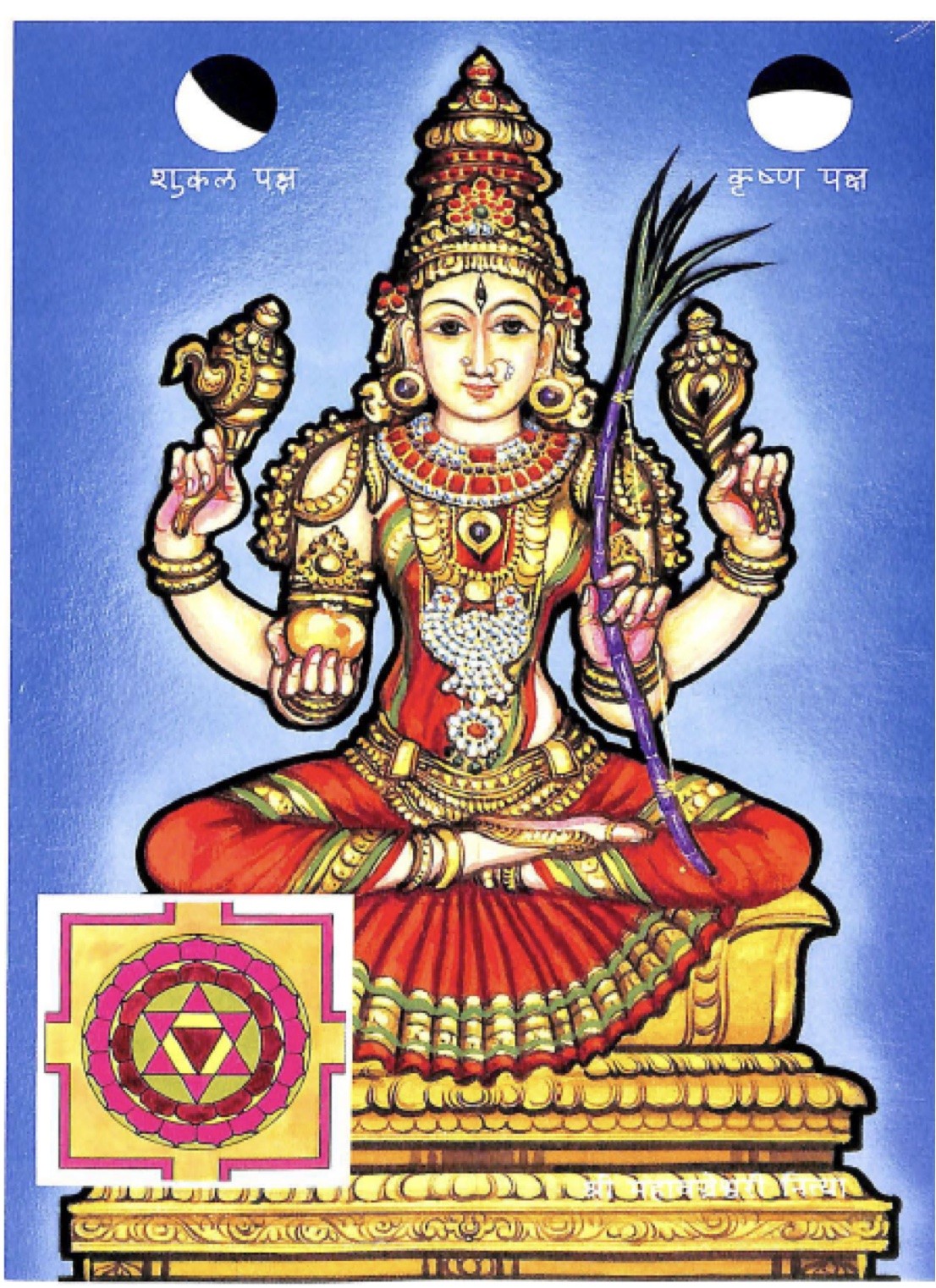
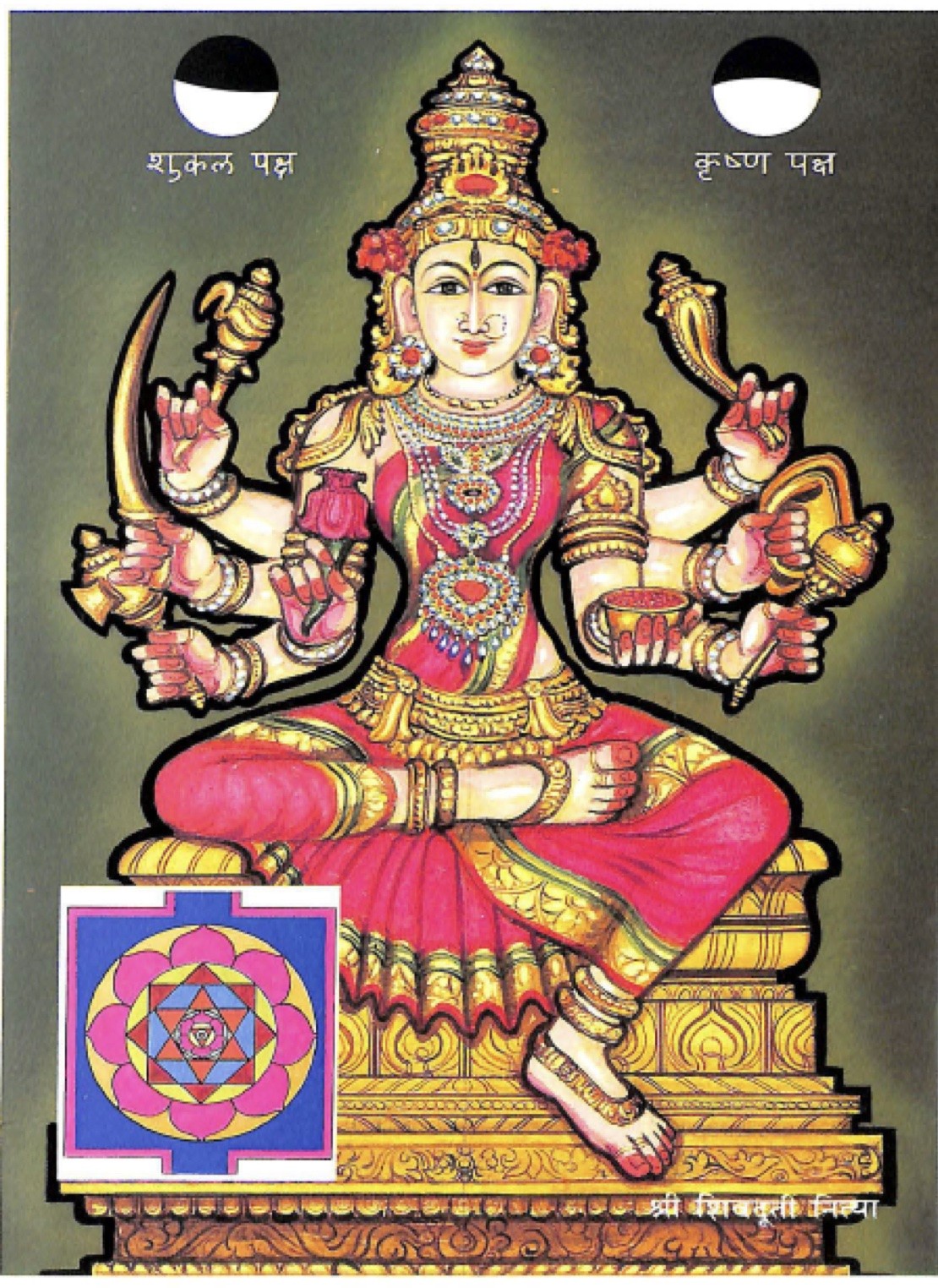
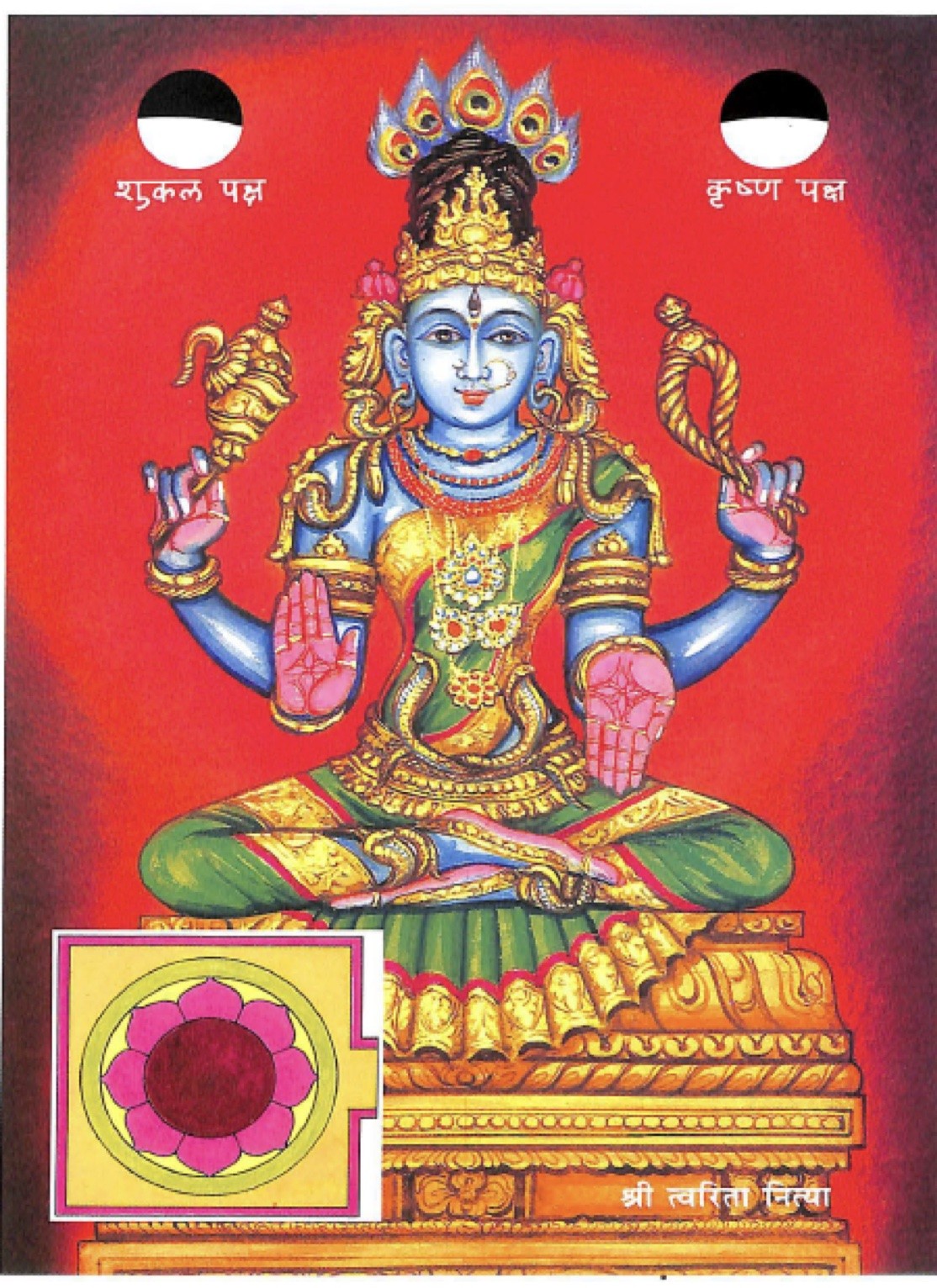 Tvarita is the ninth Nitya (Eternity) in the cycle. Also called Totala Devi. She is called Tvarita ("Swift") as She grants fruit to the sadhaka quickly. She is of auspicious form, in the first flush of youth, and dark in colour. She has 3 eyes and 4 hands and Her beautiful lotus-like face smiles gently. She is clad in new leaves. She is adorned with 8 fierce and great serpents of 4 kinds, and with waist chains and anklets. On Her head is a crystal crown with a crest of peacock feathers. Her arms are adorned with bangles made of beautiful peacock feathers. She has an umbrella and a banner made of peacock feathers. She wears strings of (red) gunja berries around Her throat, and Her breasts are smeared with red sandal and kumkum. She holds noose, goad, dispels fear, and grants boons.
Tvarita is the ninth Nitya (Eternity) in the cycle. Also called Totala Devi. She is called Tvarita ("Swift") as She grants fruit to the sadhaka quickly. She is of auspicious form, in the first flush of youth, and dark in colour. She has 3 eyes and 4 hands and Her beautiful lotus-like face smiles gently. She is clad in new leaves. She is adorned with 8 fierce and great serpents of 4 kinds, and with waist chains and anklets. On Her head is a crystal crown with a crest of peacock feathers. Her arms are adorned with bangles made of beautiful peacock feathers. She has an umbrella and a banner made of peacock feathers. She wears strings of (red) gunja berries around Her throat, and Her breasts are smeared with red sandal and kumkum. She holds noose, goad, dispels fear, and grants boons.